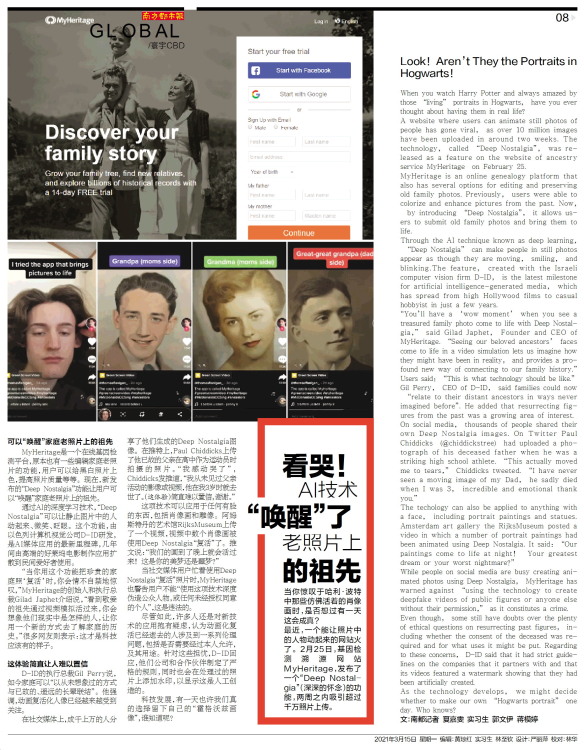

当你惊叹于哈利·波特中那些仿佛活着的肖像画时,是否想过有一天这会成真?
最近,一个能让照片中的人物动起来的网站火了。2月25日,基因检测溯源网站MyHeritage,发布了一个“Deep Nostalgia”(深深的怀念)的功能,两周之内吸引超过千万照片上传。
可以“唤醒”家庭老照片上的祖先
MyHeritage是一个在线基因检测平台,原本也有一些编辑家庭老照片的功能,用户可以给黑白照片上色,提高照片质量等等。现在,新发布的“Deep Nostalgia”功能让用户可以“唤醒”家庭老照片上的祖先。
通过AI的深度学习技术,“Deep Nostalgia”可以让静止图片中的人动起来、微笑、眨眼。这个功能,由以色列计算机视觉公司D-ID研发,是AI媒体应用的最新里程碑,几年间由高端的好莱坞电影制作应用扩散到民间爱好者使用。
“当你用这个功能把珍贵的家庭照‘复活’时,你会情不自禁地惊叹,”MyHeritage的创始人和执行总裁Gilad Japhet介绍说,“看到敬爱的祖先通过视频模拟活过来,你会想象他们现实中是怎样的人,让你用一个新的方式去了解家庭的历史。”很多网友则表示:这才是科技应该有的样子。
这体验简直让人难以置信
D-ID的执行总裁Gil Perry说,如今家庭可以“以从未想象过的方式与已故的、遥远的长辈联结”。他强调,动画复活化人像已经越来越受到关注。
在社交媒体上,成千上万的人分享了他们生成的Deep Nostalgia图像。在推特上,Paul Chiddicks上传了他已故的父亲在高中作为运动员时拍摄的照片。“我感动哭了”,Chiddicks发推道,“我从未见过父亲活动的影像或视频,他在我3岁时就去世了。(这体验)简直难以置信,谢谢。”
这项技术可以应用于任何有脸的东西,包括肖像画和雕像。阿姆斯特丹的艺术馆RijksMuseum上传了一个视频,视频中数个肖像画被使用Deep Nostalgia“复活”了。推文说:“我们的画到了晚上就会活过来!这是你的美梦还是噩梦?”
当社交媒体用户忙着使用Deep Nostalgia“复活”照片时,MyHeritage也警告用户不能“使用这项技术深度伪造公众人物,或任何未经授权同意的个人”,这是违法的。
尽管如此,许多人还是对新技术的应用抱有疑虑,认为动画化复活已经逝去的人涉及到一系列伦理问题,包括是否需要经过本人允许,及其用途。针对这些担忧,D-ID回应,他们公司和合作伙伴制定了严格的规则,同时也会在处理过的照片上添加水印,以显示这是人工创造的。
科技发展,有一天也许我们真的选择留下自己的“霍格沃兹画像”,谁知道呢?
Look!Aren’t They the Portraits in Hogwarts!
When you watch Harry Potter and always amazed by those “living” portraits in Hogwarts, have you ever thought about having them in real life?
A website where users can animate still photos of people has gone viral, as over 10 million images have been uploaded in around two weeks. The technology, called “Deep Nostalgia”, was released as a feature on the website of ancestry service MyHeritage
on February 25.MyHeritage is an online genealogy platform that also has several options for editing and preserving old family photos. Previously, users were able to colorize and enhance pictures from the past. Now, by introducing “Deep Nostalgia”, it allows users to submit old family photos and bring them to life.
Through the AI technique known as deep learning, “Deep Nostalgia” can make people in still photos appear as though they are moving, smiling, and blinking.The feature, created with the Israeli computer vision firm D-ID, is the latest milestone for artificial intelligence-generated media, which has spread from high Hollywood films to casual hobbyist in just a few years.
“You’ll have a ‘wow moment’ when you see a treasured family photo come to life with Deep Nostalgia,” said Gilad Japhet, Founder and CEO of MyHeritage. “Seeing our beloved ancestors’ faces come to life in a video simulation lets us imagine how they might have been in reality, and provides a profound new way of connecting to our family history.”Users said: “This is what technology should be like.”
Gil Perry, CEO of D-ID, said families could now “relate to their distant ancestors in ways never imagined before”. He added that resurrecting figures from the past was a growing area of interest.
On social media, thousands of people shared their own Deep Nostalgia images. On Twitter Paul Chiddicks (@chiddickstree) had uploaded a photograph of his deceased father when he was a striking high school athlete. “This actually moved me to tears,” Chiddicks tweeted. “I have never seen a moving image of my Dad, he sadly died when I was 3, incredible and emotional thank you.”
The techology can also be applied to anything with a face, including portrait paintings and statues. Amsterdam art gallery the RijksMuseum posted a video in which a number of portrait paintings had been animated using Deep Nostalgia. It said: “Our paintings come to life at night! Your greatest dream or your worst nightmare?”
While people on social media are busy creating animated photos using Deep Nostalgia, MyHeritage has warned against “using the technology to create deepfake videos of public figures or anyone else without their permission,” as it constitutes a crime.
Even though, some still have doubts over the plenty of ethical questions on resurrecting past figures, including whether the consent of the deceased was required and for what uses it might be put. Regarding to these concerns, D-ID said that it had strict guidelines on the companies that it partners with and that its videos featured a watermark showing that they had been artificially created.
As the technology develops, we might decide whether to make our own “Hogwarts portrait” one day. Who knows?
文:南都记者 夏嘉雯 实习生 郭文伊 蒋模婷

